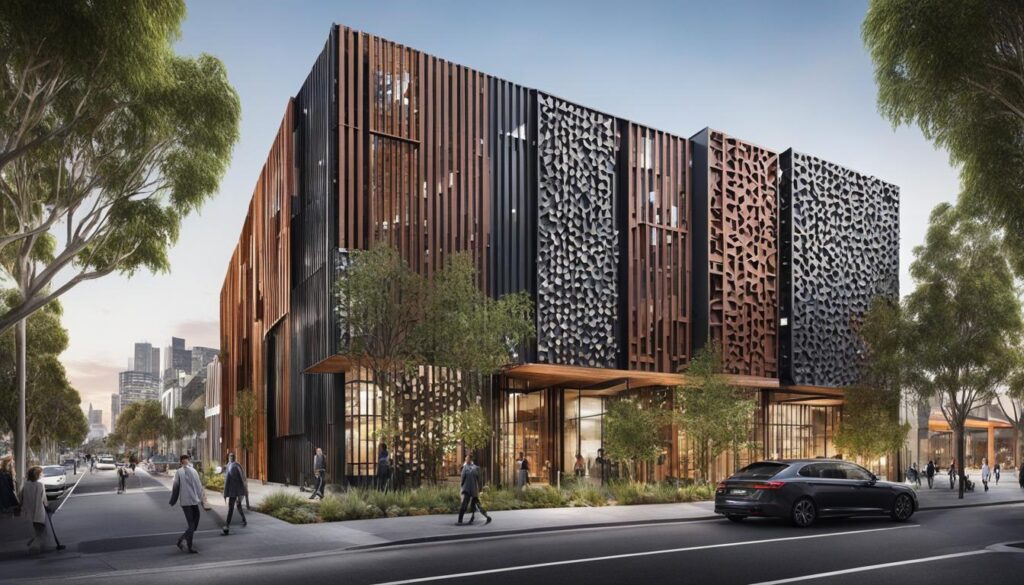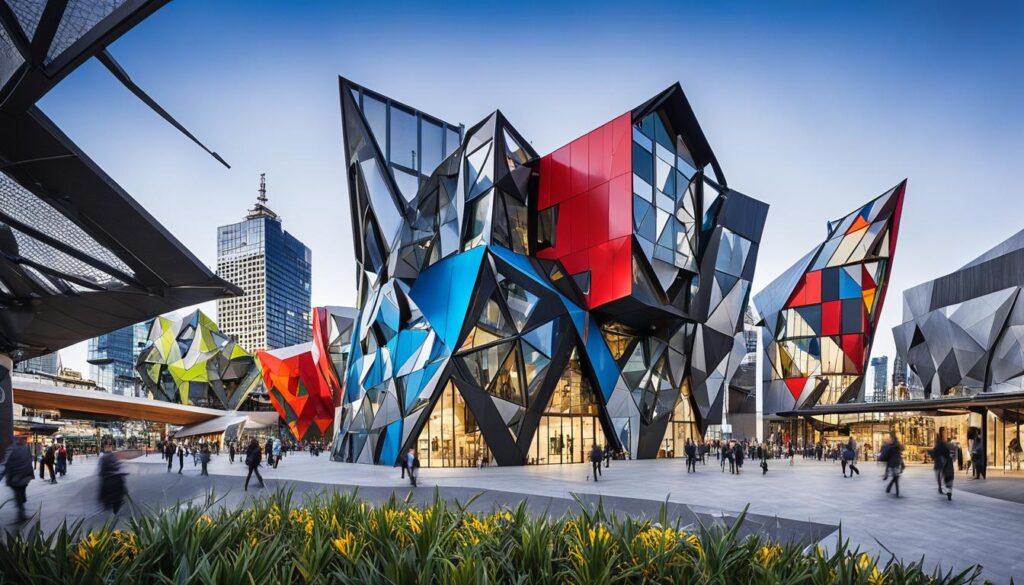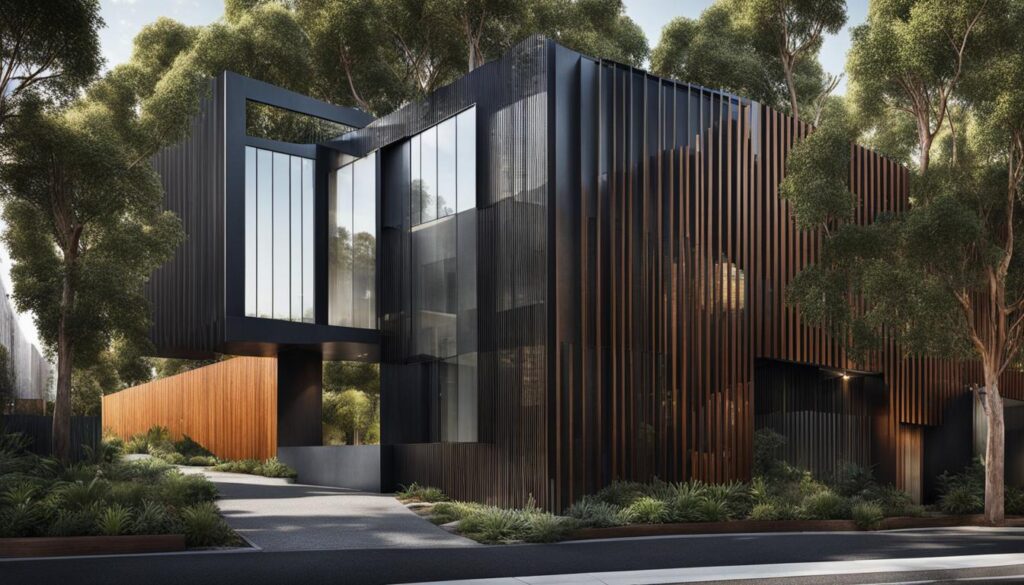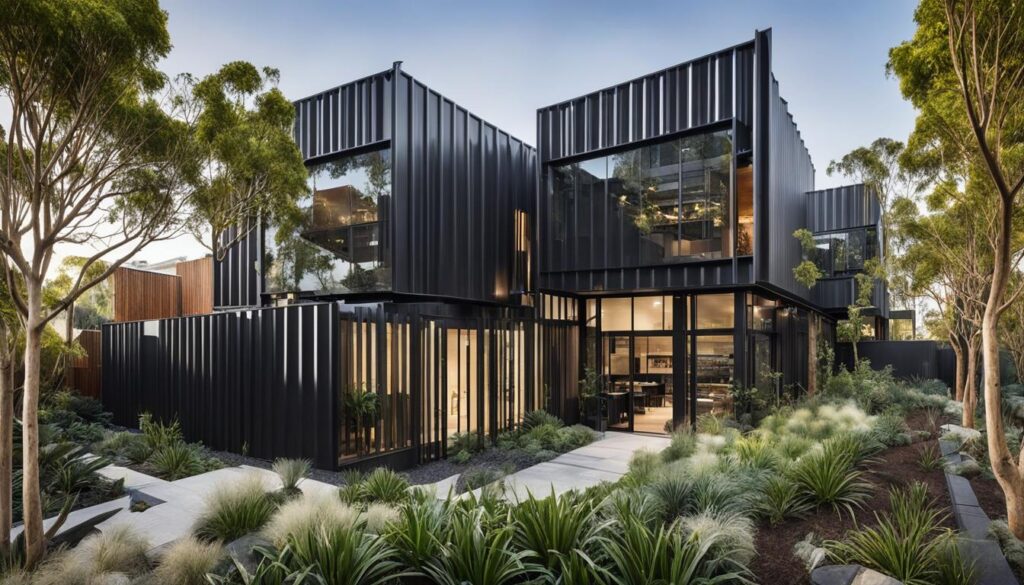In this article, we will explore the innovative uses of recycled steel in Melbourne’s eco-friendly architecture and how it is shaping a sustainable urban landscape. By leveraging the versatility and durability of recycled steel, architects in Melbourne are embracing environmentally friendly building materials to create sustainable steel structures that contribute to a greener cityscape.
Key Takeaways
- Recycled steel is a sustainable alternative to traditional building materials in architecture
- Melbourne’s eco-friendly architecture showcases innovative uses of recycled steel to create sustainable steel structures
- By repurposing steel, we can reduce the demand for virgin materials and divert waste from landfills
- Advancements in steel recycling techniques enable the efficient separation of steel from other materials, ensuring a higher degree of purity and quality
- The future prospects for recycled steel in architecture look promising as architects and builders prioritize sustainability in construction
Benefits of Utilising Recycled Steel in Architecture
At our company, we understand the importance of prioritising sustainable design in architecture. That’s why we utilize recycled steel in our eco-buildings whenever possible, taking advantage of the range of benefits it offers for environmentally friendly construction. By repurposing steel, we can decrease the demand for virgin materials, reducing the environmental impact of mining and processing operations. Additionally, by diverting steel waste from landfills through recycling, we help to reduce the volume of waste going into our limited landfill space, promoting a more responsible approach to the use of resources.
Incorporating recycled steel into our eco buildings also promotes the use of environmentally friendly building materials. We believe that using sustainable materials in our constructions is crucial to promote a more sustainable construction industry. By contrast, using non-sustainable materials such as traditional steel and concrete can be costly, resource-intensive, and may contribute heavily to greenhouse gas emissions.
Recycling steel produces less greenhouse gas emissions than manufacturing new steel, reducing the energy consumption during the production process, which in turn reduces the overall carbon footprint. By utilizing recycled steel in architecture, we can preserve the natural resources of our environment, and utilise them in a sustainable manner for our future generations.
Innovative Steel Applications in Melbourne’s Architecture
Melbourne’s eco-friendly architecture is characterized by the innovative use of recycled steel. Steel is a versatile and durable material, making it an ideal choice for architects looking to create sustainable steel structures that blend aesthetics with function. Let’s explore some of the unique ways Melbourne’s architects are incorporating recycled steel into their designs.
Salvaged Steel Beams as Architectural Features
Architects in Melbourne are breathing new life into salvaged steel beams, repurposing them as architectural features in buildings. Some architects have incorporated these beams as a design element, using them to create unique and aesthetically pleasing features that serve as the focal point of a room. Salvaged steel beams can also be used to create structural support for load-bearing walls, allowing architects to create open-concept spaces while still maintaining the structural integrity of the building.

Recycled Steel in Load-Bearing Structures
Melbourne’s architects are also embracing the use of recycled steel in load-bearing structures. The versatility of steel allows architects to incorporate it into a wide range of structural elements, including beams, columns, and trusses. Recycled steel can be used to create structures that are not only strong and durable but also environmentally sustainable.
Sustainable Steel Structures
By incorporating recycled steel into their designs, architects in Melbourne are creating sustainable steel structures that contribute to the city’s eco-friendly architecture landscape. In addition to reducing the carbon footprint of the building industry, sustainable steel structures offer energy efficiency benefits, helping to reduce energy consumption and minimize the impact of the built environment on the natural world.
Evolution of Steel Recycling in Melbourne’s Construction Industry
As the importance of sustainable construction practices continues to grow, there has been a significant evolution in the way steel is recycled in Melbourne’s construction industry.
The concept of using recycled steel for sustainable construction has become more prevalent over the years. Architects and builders have recognized the environmental benefits of incorporating recycled steel into their designs to reduce the carbon footprint of the built environment. This resurgence in the use of recycled steel has led to the development of eco-friendly construction methods while conserving natural resources.
In recent years, Melbourne has become a pioneer in designing eco-friendly buildings that take advantage of the unique properties of recycled steel. With sprawling urbanization and growing environmental awareness, the use of recycled steel in sustainable design has become more relevant in Melbourne’s green architecture.
Advantages of Steel Recycling in Sustainable Design
Recycling steel helps to conserve vital resources by reducing the dependence on raw materials. For instance, recycled steel from old structures can be used to build new green buildings, negating the need for virgin steel which requires more energy and resources to produce.
Sustainable Construction with Recycled Steel
Steel recycling is an environmentally friendly approach that promotes sustainable construction practices. Using recycled steel in construction helps to reduce the carbon footprint of the industry while promoting resource conservation.
The use of recycled steel in sustainable construction promotes resource conservation and reduces the carbon footprint of the construction industry.
Steel Recycling Techniques
Advanced steel recycling techniques such as magnetic separation, laser sorting, and color sorting have become more prevalent in Melbourne’s construction industry. The progressive technology allows for efficient separation of steel from other materials and increased steel purity. As the standards of recycled steel improve, companies have become more confident in using recycled steel in their sustainable construction efforts.
Incorporating Recycled Steel into Construction
| Building | Location | Steel Recycling Techniques |
|---|---|---|
| CH2 Building | Melbourne | Laser Sorting |
| 101 Collins Street | Melbourne | Magnetic Separation and Laser Sorting |
| Epworth Hospital | Richmond | Magnetic Separation and Laser Sorting |
Several eco-friendly buildings in Melbourne illustrate the successful incorporation of recycled steel.
- The Council House 2 (CH2) Building in Melbourne was the first to receive a 6-star green rating for environmental design. The standout features of this building include the salvaged steel beams, recycled timber, and a double-skinned facade, which all contribute to its impressive energy efficiency.
- 101 Collins Street is another notable example of sustainable construction with recycled steel in Melbourne. The building’s steel beams were carefully dismantled, sorted, and recycled during the renovation process. Advanced laser and magnetic separation technologies were used to sort and clean various steel elements, and over 95% of the old steel was reused, resulting in significant energy savings.
- Epworth Hospital in Richmond is yet another example of green architecture that uses recycled steel. Laser and magnetic separation techniques were used to recycle the steel, decreasing waste and promoting resource conservation in the construction process.
These case studies prove that incorporating recycled steel into construction projects can promote sustainability while preserving natural resources. As the demand for eco-friendly architecture continues to grow, the integration of recycled steel in sustainable design is essential for creating a more sustainable future.
Case Studies: Iconic Eco-Friendly Buildings in Melbourne
When it comes to showcasing the innovative use of recycled steel in Green Architecture Melbourne, several iconic buildings stand out. These structures embody the essence of sustainable design, blending functionality with exceptional aesthetic appeal while featuring recycled steel as a fundamental element. Below, we explore some of the most impressive eco-friendly buildings in Melbourne and how they utilize recycled steel:
Melbourne School of Design
The Melbourne School of Design is a prime example of innovative steel applications in Green Architecture Melbourne. The building features a striking green roof with garden spaces, rainwater harvesting systems, and solar panels. Recycled steel was used to construct the load-bearing structure, showcasing how steel recycling in sustainable design can contribute to energy-efficient buildings.

Melbourne Museum
The Melbourne Museum is another impressive example of eco-friendly architecture in Melbourne. The museum’s structure features a unique ‘shotgun’ design, with recycled steel used extensively throughout the building. The steel framing was created from salvaged railway tracks, reinforcing the ethos of sustainable construction. The Melbourne Museum is an embodiment of how Green Architecture Melbourne utilises recycled steel.
CH2 Building
The CH2 building is a true masterpiece of Green Architecture Melbourne, incorporating sustainable design in every facet of its structure. The building features an extensive use of recycled steel in its steel structural framing, reducing the environmental impact of the building. The CH2 Building is a commendable example of how sustainable construction with recycled steel materials can deliver aesthetic, functional, and energy-efficient architecture.
These iconic buildings attest to the creative and innovative use of recycled steel in Green Architecture Melbourne. Through sustainable design and the use of eco-friendly building materials, Melbourne stands out as a leader in sustainable architecture, paving the way for a greener and more sustainable future.
Collaborative Efforts towards Sustainable Steel Construction
At the heart of achieving sustainable steel construction lies collaborative efforts between architects, engineers, and steel manufacturers. These partnerships foster a shared commitment towards utilizing environmentally friendly materials and methods in construction. At the same time, the innovative use of advanced technologies enables Melbourne’s construction industry to optimize the use of recycled steel.
Through collaborative efforts, the use of recycled steel in sustainable design has become increasingly prevalent in Melbourne’s architecture. These efforts ensure that sustainability is always at the forefront of every architectural project, promoting the use of recycled steel in sustainable design and construction.
One of the key advantages of collaborative efforts towards sustainable steel construction is the ability to optimize the use of recycled steel. Steel recycling in sustainable design reduces the carbon footprint of the built environment by decreasing the demand for virgin materials, reducing energy consumption during manufacturing, and diverting waste from landfills.
Promoting Sustainable Construction with Recycled Steel
By incorporating recycled steel into eco buildings, Melbourne’s architects and builders promote the use of environmentally friendly building materials. Sustainable construction with recycled steel creates structures that not only provide exceptional functionality and energy efficiency but also blend seamlessly with the city’s urban landscape.
“We work closely with architects and engineers to incorporate recycled steel into our construction projects,” says Max Smith, managing director of Green Construction Group. “We believe that by collaborating with our partners, we can achieve the highest levels of sustainability in our construction projects.”
The Benefits of Collaborative Efforts
Collaborative efforts towards sustainable steel construction are critical for several reasons.
- By leveraging the strengths of each partner, we can optimize the use of recycled steel in construction projects.
- Partnerships promote the sharing of knowledge, skills, and technologies, spurring innovation in sustainable design and construction.
- Collaborative efforts encourage a more environmentally conscious construction industry, contributing to a greener future for all.
Advancements in Steel Recycling Techniques
Our commitment to sustainable architecture in Melbourne has led to the increased use of recycled steel in building construction. Advancements in steel recycling techniques have played a crucial role in the innovative uses of recycled steel in eco-friendly architecture.
The latest cutting-edge technologies, such as magnetic separation and laser sorting have enabled us to separate steel from other materials efficiently. This ensures a higher degree of purity and quality, expanding the possibilities for incorporating recycled steel into architectural designs. These innovative techniques promote sustainability and resource conservation in Melbourne’s construction industry.

Higher degree of purity and quality
Magnetic separation techniques have made it possible to remove impurities from recycled steel, such as residual paints or adhesives that might compromise its strength and durability. Laser sorting also enables the separation of different grades of steel, facilitating specific uses according to the structural demands of different parts of a building.
Versatility of recycled steel
These advances in steel recycling techniques have also made it possible to utilize innovative uses of recycled steel in designing sustainable structures. Recycled steel beams, for example, have become a popular architectural ingredient for its aesthetics and functionality. The versatility of recycled steel allows architects to design complex structures with ease, reducing waste and increasing energy efficiency in construction.
Efforts towards Sustainable Steel Construction
The collaborative efforts between architects, engineers and steel manufacturers are crucial in achieving sustainable steel construction in Melbourne and beyond. By utilizing advanced technologies and promoting the use of environmentally friendly building materials such as recycled steel, the construction industry in Melbourne is actively working towards reducing the city’s carbon footprint while developing innovative and functional structures that bring sustainable urban development to life.
Future Prospects for Recycled Steel in Architecture
Innovative steel applications in Melbourne’s eco-friendly architecture demonstrate the significant potential of recycled steel as a sustainable alternative to traditional building materials. As environmental concerns continue to shape the construction industry, architects and designers are increasingly turning to recycled steel to create sustainable steel structures that contribute to a greener urban landscape.
With further advancements in steel recycling techniques, we can expect to see an expansion of innovative applications of recycled steel in recycled steel architecture. The versatility and durability of recycled steel make it an ideal material for creating aesthetically pleasing, functional, and environmentally friendly structures.
The Benefits of Using Recycled Steel in Sustainable Construction
The use of recycled steel in sustainable construction has several benefits, including:
| Benefits | Description |
|---|---|
| Reduced carbon footprint | Steel recycling decreases the demand for virgin materials, reduces energy consumption during the manufacturing process, and diverts waste from landfills. |
| Promotion of eco-friendly building materials | By incorporating recycled steel into construction, designers and architects promote the use of environmentally friendly building materials in the industry. |
| Cost reduction | Using recycled steel in construction reduces material costs and waste disposal expenses. |
The use of recycled steel has become increasingly prevalent in Melbourne’s construction industry as the sector embraces sustainable development. Architects and builders have optimized the use of recycled steel while reducing the environmental impact of the built environment.
Innovative Steel Applications for Sustainable Construction
Architects in Melbourne are embracing the versatility and durability of recycled steel to create sustainable steel structures that blend aesthetics with function. From using salvaged steel beams as architectural features to incorporating recycled steel into load-bearing structures, innovative steel applications contribute to the city’s eco-friendly architecture landscape.
With further advancements in steel recycling techniques and ongoing research and development, the range of applications for recycled steel is likely to grow. Melbourne’s eco-friendly architecture serves as an inspiring example of how innovative steel applications can help shape a sustainable urban landscape.
The Way Forward: Collaborative Efforts and Advancements in Steel Recycling Techniques
To achieve sustainable steel construction, architects, engineers, and steel manufacturers must collaborate to optimize the use of recycled steel. Research and development into cutting-edge technologies, such as magnetic separation and laser sorting, have already expanded the possibilities for incorporating recycled steel into architectural designs.
The future of recycled steel architecture is promising, with architects and designers increasingly turning to sustainable and environmentally friendly building materials. Melbourne is leading the way, and collaborative efforts and advancements in steel recycling techniques are paving the way for a greener and more environmentally conscious construction industry.
Conclusion
In conclusion, Melbourne’s eco-friendly architecture demonstrates how innovative uses of recycled steel can shape a sustainable urban landscape. By utilising recycled steel in sustainable construction, we are reducing the environmental impact of the built environment while creating aesthetically pleasing and functional structures.
Through collaborative efforts, advancements in steel recycling techniques, and a commitment to sustainability, Melbourne serves as an inspiring example of how recycled steel can drive environmentally friendly architecture.
As we move towards a more sustainable future, it is essential to continue exploring the possibilities of recycled steel in architecture. With further research, development, and advancements in steel recycling techniques, we can expect to see even more innovative applications of recycled steel in Melbourne’s eco-friendly architecture and beyond.
FAQ
What are the benefits of using recycled steel in architecture?
Using recycled steel in architecture offers a range of benefits for sustainable design. It helps decrease the demand for virgin materials, reduces energy consumption during manufacturing, and diverts waste from landfills. Incorporating recycled steel into eco buildings promotes the use of environmentally friendly building materials, contributing to a more sustainable construction industry.
How is recycled steel being used innovatively in Melbourne’s architecture?
Architects in Melbourne are embracing the versatility of recycled steel and using it in innovative ways. They incorporate salvaged steel beams as architectural features and incorporate recycled steel into load-bearing structures. This approach results in sustainable steel structures that blend aesthetics with function, contributing to the city’s eco-friendly architecture landscape.
How has steel recycling evolved in Melbourne’s construction industry?
Over the years, the construction industry in Melbourne has witnessed a significant evolution in steel recycling practices. With the growing focus on sustainable development, architects and builders have increasingly incorporated recycled steel into their designs to reduce the carbon footprint of the built environment. This evolution has helped establish sustainable construction practices in Melbourne.
Can you provide examples of iconic eco-friendly buildings in Melbourne that showcase the innovative use of recycled steel?
Certainly! The Melbourne School of Design features a striking green roof that showcases the innovative use of recycled steel. The Melbourne Museum is another example of a structurally impressive building that incorporates recycled steel. These buildings demonstrate how sustainable steel structures can blend seamlessly with the urban landscape while providing exceptional functionality and energy efficiency.
How does collaborative effort contribute to sustainable steel construction in Melbourne?
Achieving sustainable steel construction requires collaborative efforts between architects, engineers, and steel manufacturers. Through partnerships and the use of advanced technologies, Melbourne’s construction industry has been able to optimize the use of recycled steel. This collaboration ensures that sustainability is at the forefront of every architectural project, paving the way for a greener and more environmentally conscious construction industry.
What advancements in steel recycling techniques have contributed to innovative uses of recycled steel in Melbourne’s architecture?
Advancements in steel recycling techniques, such as magnetic separation and laser sorting, have played a crucial role in the innovative uses of recycled steel in Melbourne’s eco-friendly architecture. These technologies enable efficient separation of steel from other materials, ensuring a higher degree of purity and quality. These advancements have expanded the possibilities of incorporating recycled steel into architectural designs, promoting sustainability and resource conservation.
What are the future prospects for recycled steel in architecture?
The future prospects for recycled steel in architecture are promising. As environmental concerns shape the construction industry, architects and designers are increasingly turning to recycled steel as a sustainable alternative to traditional building materials. Continued advancements in steel recycling techniques and ongoing research and development will pave the way for even more innovative applications of recycled steel in Melbourne’s eco-friendly architecture.
